Story of the Plants
Term: December 1 – 23, 2020
Artist: Tatsuya Mizoguchi
Website: https://landscipe.jp/
The 15th exhibition at ITbM Gallery presented an exhibition titled “Story of the Plants” by a landscapist, Tatsuya Mizoguchi. The exhibition introduced the concept and works of Landscipe, a group of landscape architects who seek a form of nature and create gardens by interacting with nature.
*English translation: Edmund Rhind-Tutt
Landscipe Maintenance
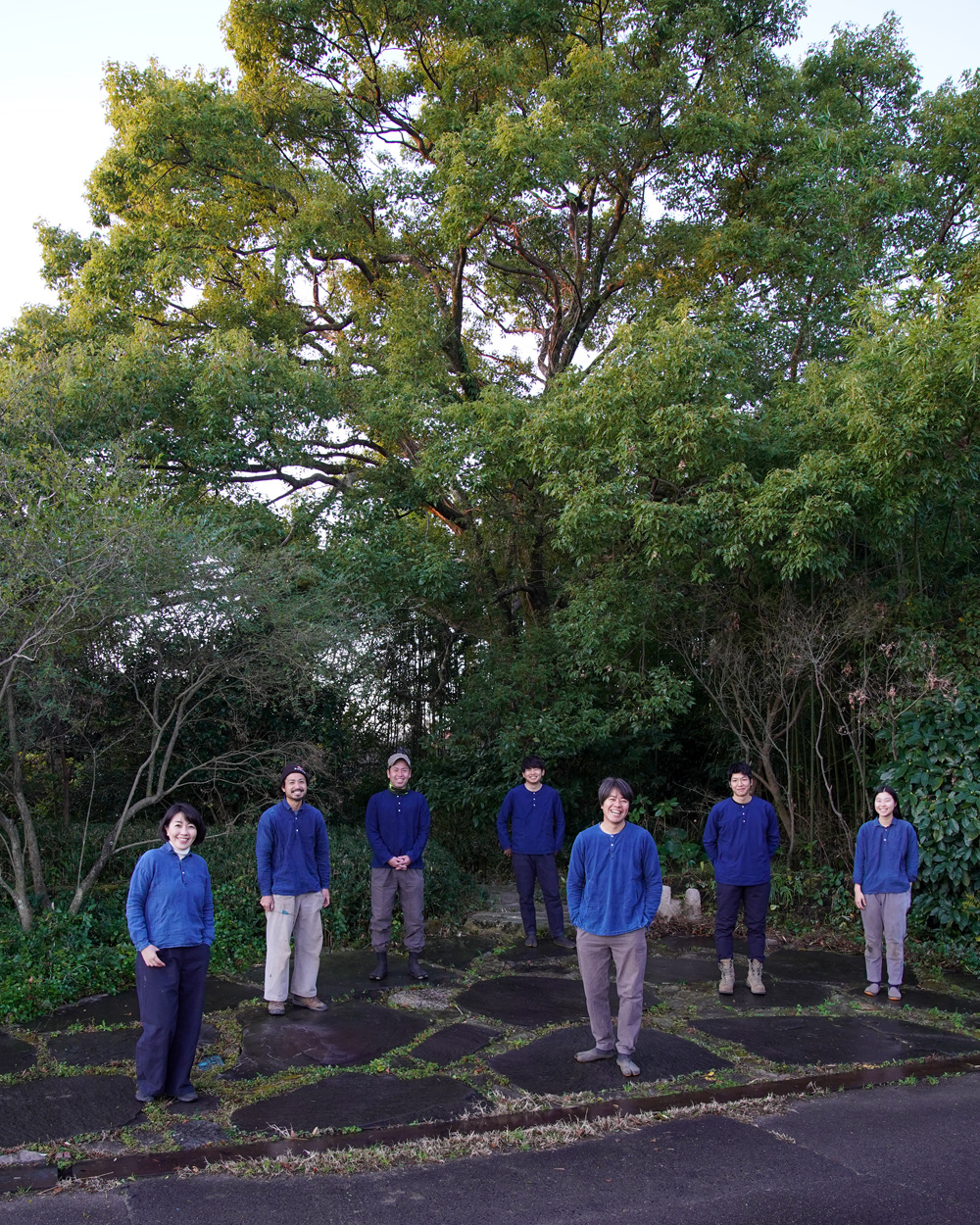
剪定: 無剪定の楠の優雅に広がる枝。自然の木々は剪定が必要ないように、成長点を切るという剪定行為は、生き物のバランスを崩してしまうので、慎重にならなくてはいけない。よく観察し、謙虚な気持ちで内に向いた枝や、立枝、枯れ枝などを間引く。後は木漏れ日を感じながら葉を毟る。作業にしてはならない、木と対話する貴重な時間である。
消毒: 消毒も除草剤も撒かない。消毒をすれば、虫に葉や幹を食べられることはなく、除草剤を撒けば、草取りや草刈りに徒労することはない。しかし薬を撒かれた木々は、次第に自然治癒力を失い、与え続けないと、虫の大量発生が生じたりする。除草剤を撒かれた大地は、草だけでなく地中の微生物も殺してしまうため、循環が絶たれどんどん不毛な地になっていく。表面的に目に入るものと、その奥にある真実。本当の美しさとは何であろうか。
Pruning: An unpruned camphor branch stretches out elegantly. A great deal of care is required to keep natural trees away from the kind of pruning that cuts off new growth and upsets their natural balance. Careful observation of each tree, and the thinning out of turned-in, standing and dead branches, followed by the picking of leaves to keep light flowing through. This is not just maintenance, it is precious time spent in dialogue with the trees.
Chemical treatments: We do not use pesticides or weed killers. Sure, if we used pesticides, the leaves and branches wouldn’t be eaten by insects. If we used weed killers, we wouldn’t have to spend time pulling and cutting weeds. However, trees that have been treated like this lose their natural healing ability over generations, and if these new trees are not also treated, they are susceptible to issues such as large insect infestations. Moreover, if an area is widely treated with weed killers, it kills not only the weeds themselves but microorganisms in the soil, interrupting the natural cycle and eventually rendering the earth barren. Nothing comes from ensuring beauty on the surface when you destroy what is beneath it.
Landscipe Showroom
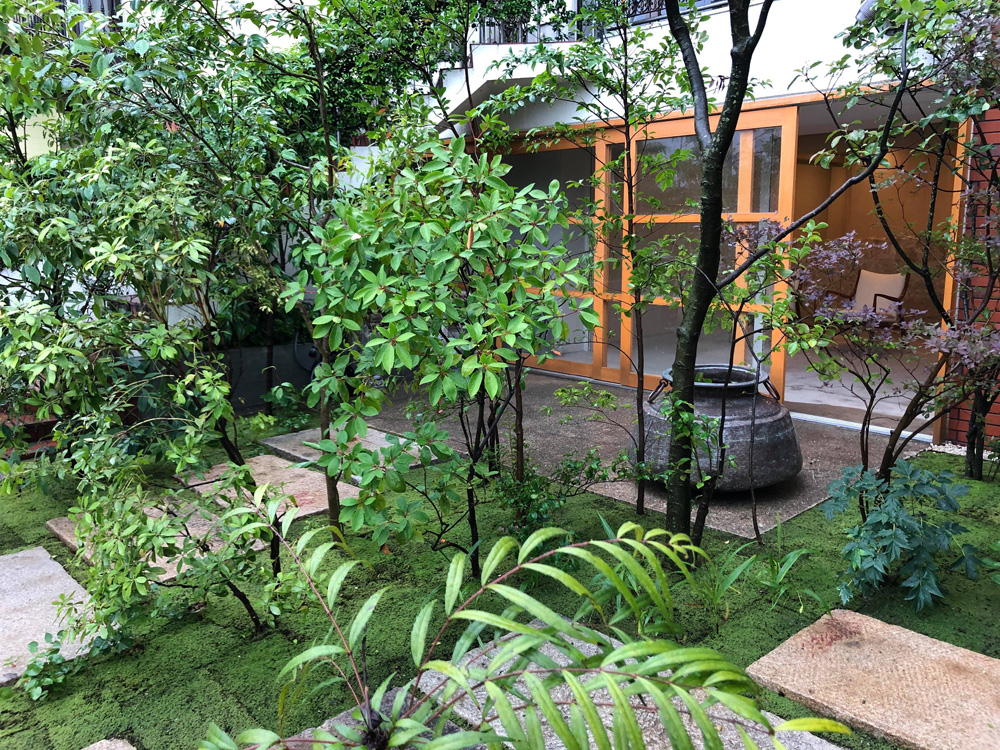
Landscipeは、「庭/ニハ」いう分野において、自然を分母にしたものづくりを約40年続けてきました。私たちが、「ニハ」というのは、諸説ある「庭」の語源によります。神事、狩猟、農事などを行う場であった「土=ニ 場=ハ」は、私たちが表現したいものにとても近いと感じるからです。古来、日本では、人は自然の一部であるという自然観がありました。日頃はあまり意識することはありませんが、人のものの見方や考え方には必ず自然観が大きな影響力を及ぼしています。自然観とは、環境や風土に伴った暮らし方が風習として生活化し、生き方として伝承されてきたものの考え方です。温暖化が進み、日本の環境も変わりつつありますが、私たちは、現代の風土に合った生き方が出来る「ニハ」を追い求めて行きたいと思います。それは、人が関わって初めて成立する場。人も木々も建築も、すべてのものが、風景になる暮らし。
この度、そんな暮らしの提案をする場をオープンさせる事となりました。人が自然の一部であるという考え方を、ただの精神論に終わらせず、その心を伝承することが、文化をつなぐことに繋がるのではないでしょうか。そして、庭文化を守り、紡いでいきたい。その思いが繋がることが私たちの願いです。
Landscipe has been working with nature to produce our gardens for about 40 years. A garden is something built on the earth. Whatever occurs there, be it things as diverse as religious rituals, hunting, agriculture - all is founded upon the soil beneath us. In ancient Japan human beings were considered a part of the natural world. Although we may not often notice it, it is certain that our outlook on nature influences the way we see and think about things. Our outlook on nature gives us a way of thinking which helps us to live in better harmony with the environment and climate. As global warming continues and Japan’s climate changes with it, we are pursuing the creation of gardens that can exist in harmony with the climate of today. These are the first places constructed and formed by humans. People, trees, buildings, all part of life’s scenery.
We have created a space in which you can experience this way of living. Taking the concept of humans as a part of the natural world out of pure spirituality involves connecting it to our culture. We strive to protect and weave anew the culture of gardening. Connecting all these ways of thinking is our desire.
循環のニハ Junkan-no-Niha

先祖が残してくれた二本の大きな楠と竹林。木漏れ日の下には、茗荷や蕗、ドクダミ、熊笹などが地表を覆う。日の当たる畑の脇には柑橘など実のなる果樹が植わる。枯れ枝、剪定枝は薪ストーブの燃料に。竹林の竹は垣根の材料になり、春には筍を供給してくれる。刈取った草や落葉はコンポストに入れて土に返し、雨水は溜池に集め、木々や畑の野菜に恵みを与える。無駄なものは何もない。人が自然と関わって共に豊かになっていくこと、自然の循環を感じられる場所。これが私達の「丹場(ニハ)」だ。
Two large camphor trees and a bamboo grove left for us by our forefathers. In the dappled light beneath, wild ginger and butterburs, chameleon plants and bamboo grasses cover the ground. Fruit trees are planted along the edge of the well-lit kitchen garden. Dead and pruned branches become fuel for the stove. Bamboo from the grove is used to build fences, and sprouts anew in the spring. Cut grass and fallen leaves are composted and rainwater collected, all of it returned to the soil to bless the trees and plants. Nothing unnecessary exists in this garden. It is a place for people to connect with nature and share in its riches, a place where the cycle of the natural world can be felt. This is our garden.
倉渕のニハ Kurabuchi-no-Niha
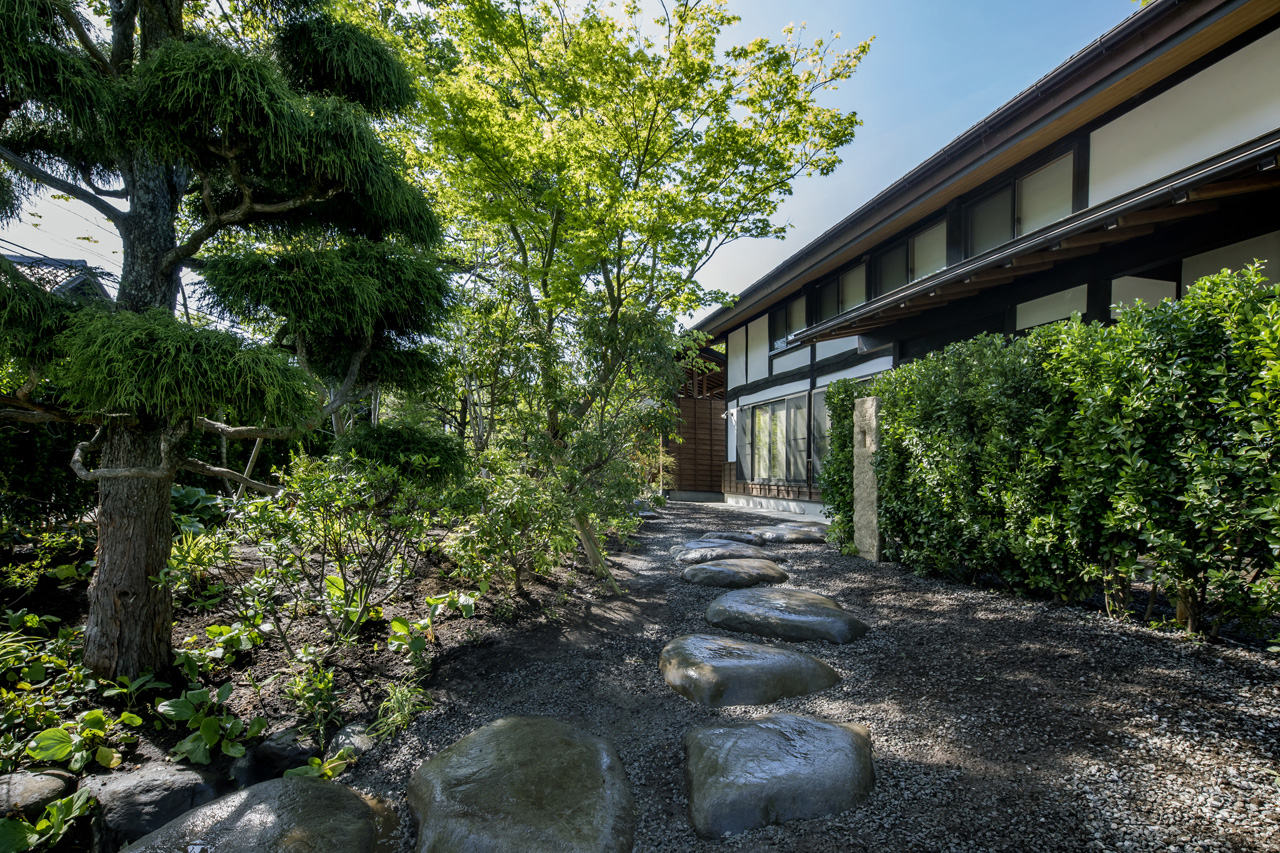
道沿いに、一定の距離を保ちながらも、閉じることをしない家々が、時間を共有している。 歩道脇を走る水路と、昔から生活用水として使われている共有の水場。 こういう(空)間に生まれるのが「にわ」であろう。 透明度の高い水の流れに橋をかけ、アプローチに。玄関までは川石の飛び石を進み、マサキの垣根を結界とした。 既存の大きな桜の足元の前庭は、地余の力を感じるように、土盛り造成した。 祖父の代からの家を丁寧に改修し、定年後の田舎暮らしを楽しむ施主。ありのままということではない。心象風景の積極創造である。
Spaced out along the side of a road, a number of expansive houses quietly pass the time together. A waterway runs along the pathway outside, flowing into a communal reservoir. Gardens are born from spaces like these. The approach is created by placing a bridge over the clear, flowing water. From there, stepping stones continue to the front door, their boundary defined by a spindle-tree hedge. In the front garden, the ground at the feet of the venerable cherry tree was raised, offering a feeling of the earth’s power. The client has spent his retirement fastidiously renovating this house, formerly owned by his grandfather. The garden was not left untouched – it is the realization of something held in the mind’s eye.
大町のニハ Omachi-no-Niha
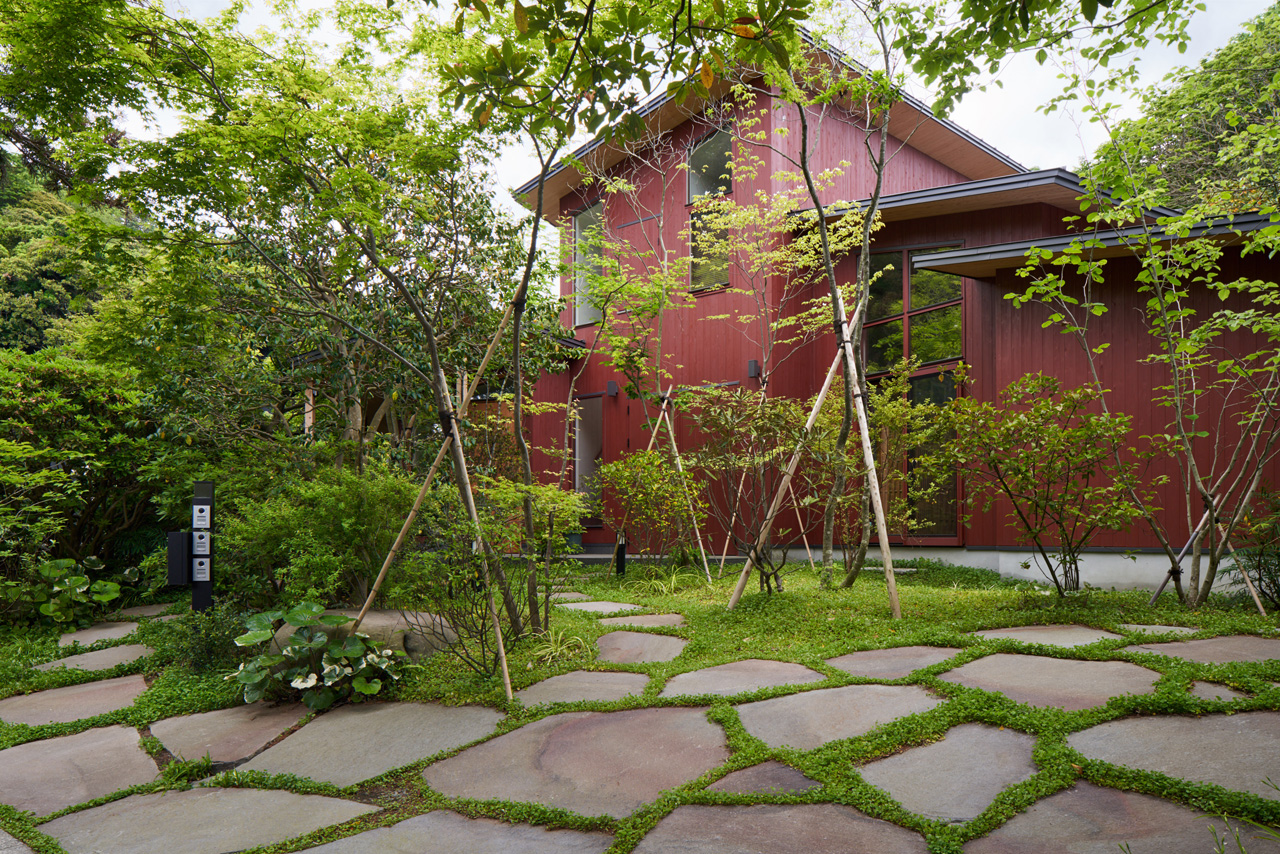
ジェフリー・バワ作品を訪ねる旅をした際に出会ったアメリカ人の旅行者。その彼らに紹介されたのが施主だった。帰国し施主と会い、初めてその計画地を訪れた時、駅まで5分の立地にありながら裏庭には山林がひろがる、バワからのプレゼントのような都会の田舎であった。風土や文化に根差したランドスケープ、そして建築。その二つが分離せず、一つの風景となっているバワの作品。そんな場を、ここだったら造れるかもしれないと、その場をよく理解し、周りの環境を最大限に取り込むことを意識した。庭は住む人が現れる場所。施主からはこの庭を愛し、最大限楽しもうとする施主の気持ちが伝わってくる。どのような庭を造るかも大事だが、このような施主と出会い、沢山話しをし想いを共有することが、一番大事なことかもしれない。
I was introduced to this client by American travelers whom I had met on a trip to visit the works of Geoffrey Bawa. When I returned to Japan and saw the site, a mere 5 minutes from a station but with woods stretching away to its rear, it felt like a gift from Bawa himself, an oasis of countryside in the city. Bawa’s work is the unification of building and landscape, rooted in natural climate and culture. Thinking that this site was the ideal base for such a work, I tried to bring the surroundings into the space as much as possible. Gardens exist because of those who live with them. I understood that this client loved his garden and wanted to enjoy it as fully as he could. While the process of constructing the garden is of course important, possibly even more significant is the process of meeting, talking with and sharing thoughts and feelings with the client themselves.
朝明の庭 Asake-no-Niwa
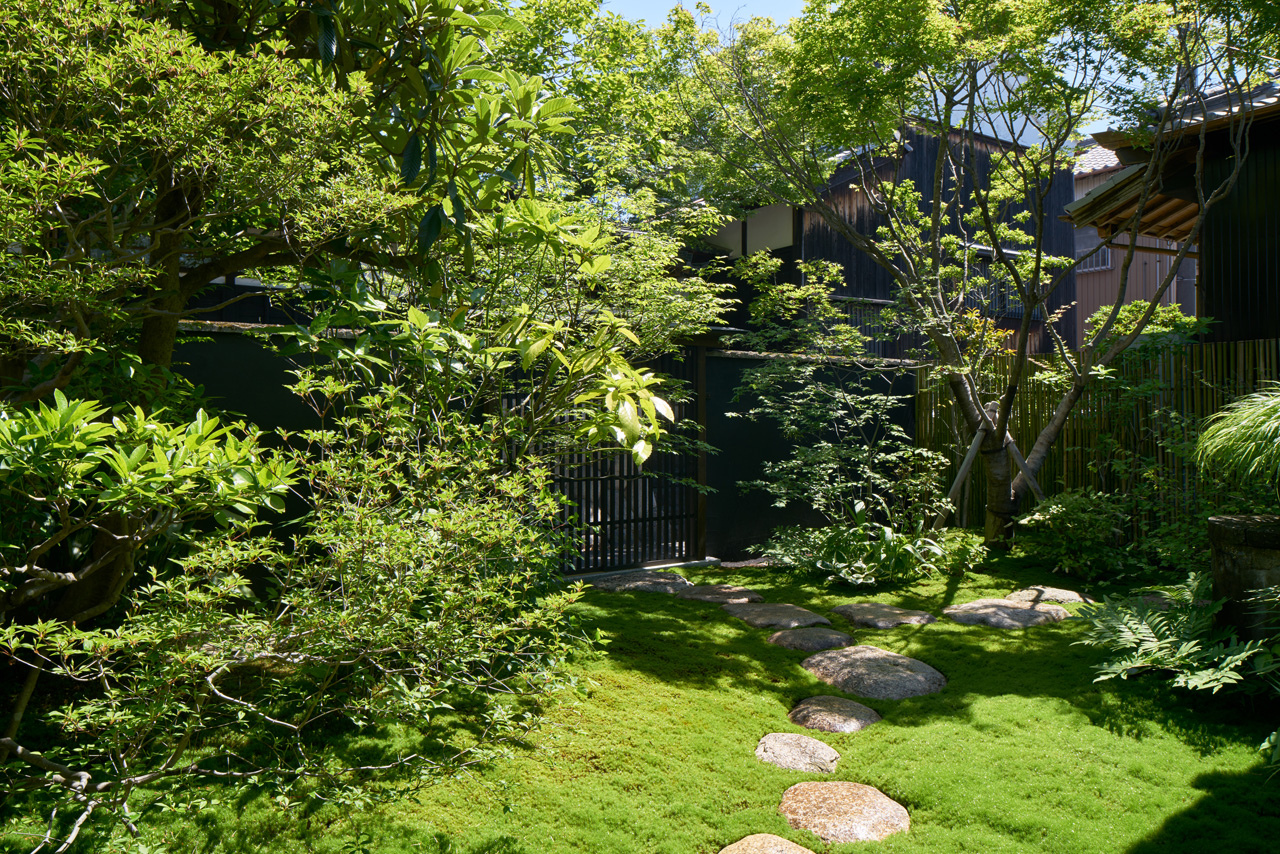
築90年の民家を改修し、新たなものとして甦らせた施主。
裏庭として使われていた場所に門扉を新たに構え、駅からの導線に、隣接するお屋敷の美しい石積みの塀を景色に取りこむ。単独で存在していた家々が急に街並みになる。どれだけ周りの環境を味方につけるかで、随分と風景が変わるものだ。裏庭で使われなくなった井戸を花台とし、家の脇を長いアプローチとする。シンボルツリーだった桜の大木は、年月とともに樹勢を弱め撤去するかが検討されたが、門扉の位置を変えることによって、アプローチ脇の近景にし、生かす。太い幹の存在を感じながら玄関にたどり着く。玄関を入ると広い土間廊下が真っすぐ走り、裏の扉を開け放つと、庭の景色が切りとられ、絵のように美しい。視点を変えると、全く違う表情が現れる。
真の豊かさとは何か。それを問うた庭だった。
Our client was breathing new life into a 90 year old home.
A new gate was installed into the former back garden, taking as its backdrop the beautiful masonry of the wall of the adjacent house, along which runs the path to the station. Houses exist individually but not in a vacuum; they suddenly take on the shape of a town. Bring the environment in which you are working over to your side, and it will change for you. Plants were placed on the disused well in the back garden, and the side of the house used for a long approach. The large cherry tree, the centerpiece of the garden, had lost its vigor with age and its removal was considered. But with the moving of the gate, it was decided to keep it as a part of the approach to the house, the solid presence of its trunk felt as one nears the door.Go through the front door and a broad, earthen-floored corridor runs straight ahead, all the way to the back. Open the back door and the garden appears, framed on four sides like a painting. Change your viewpoint, and an entirely different image appears.
What is the real meaning of ‘riches’? That is the question posed by this garden.
実生の庭 Mishou-no-Niwa
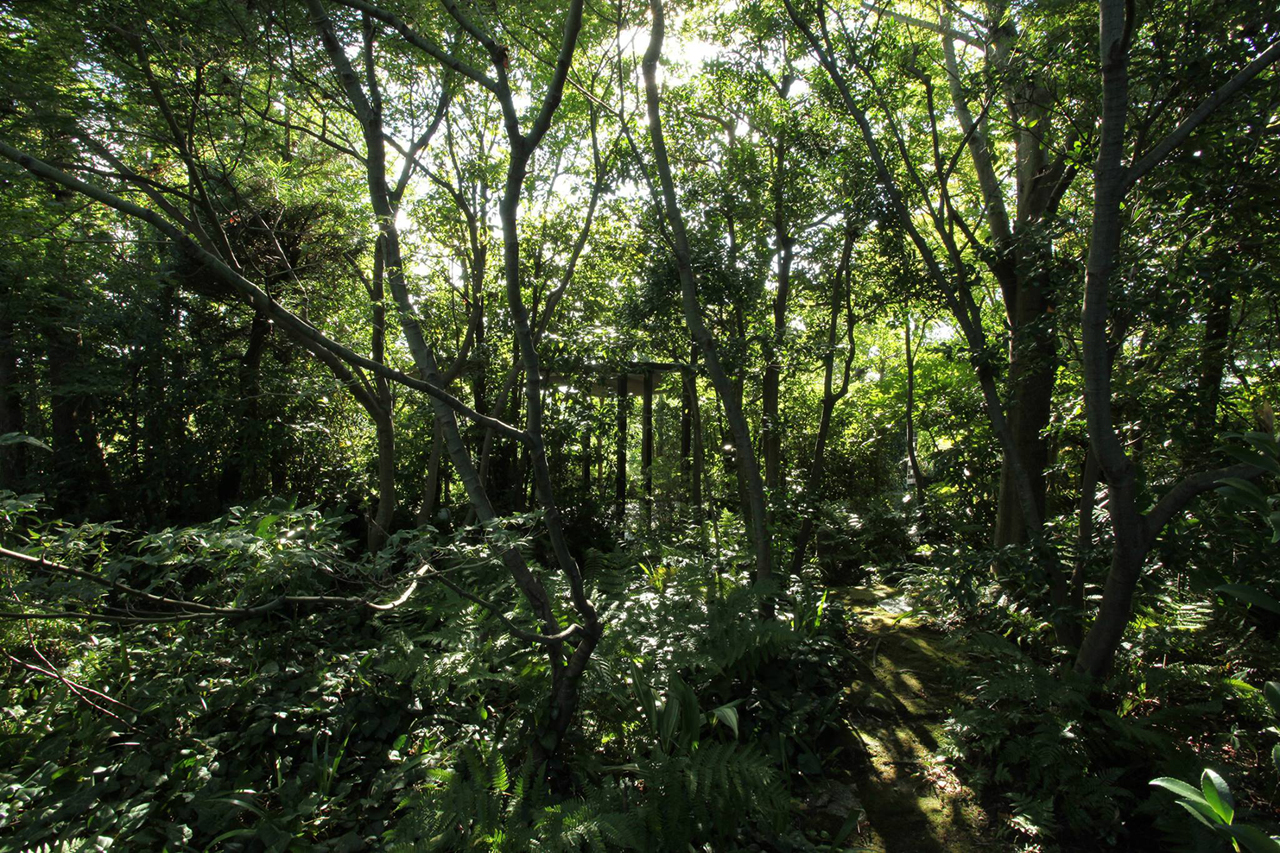
先代の父が、実験の場として40年ほど前に20本ばかりの木を植栽したこの庭は、風や鳥が運んだ種により、現在は3倍以上の木々が存在する。この庭の中心に一番大きく聳え立つ椋の木も実生だ。
実生の木々は、身分不相応の無駄な根を張らないので、幹を太らせ過ぎることもなく、光に向かう繊細で美しい幹のラインを生み出す。線は細いが自力ではった根の生命力は強い。
実生の木々たちが力をつけ始めた頃、人により植えられたもの一部は、病気になって朽ちたり、台風の際に倒れたりして、また新たな景色が生まれていく。ああしたい、こうしたいと思ってあがいたところで思い通りにはならない。好きでも環境に合わないものは育たないのだ。
偶然の積み重ねから生まれてきた命によってもたらされるものを受け入れ、それらの変化を楽しむ事が、これからの新しい庭のカタチとなり、それがいつかどこかで見た懐かしい風景へと近づくのではないかと思う。
Their seeds carried by the wind and the birds, the 20 trees planted by my father for his experiments 40 years ago have more than tripled in number. The muku tree that stands tallest at the center was grown from a single seed.
Trees grown from seed lay down no more roots than necessary for their existence, and their trunks stay slim, forming delicately beautiful silhouettes against the light. While their roots are thin, the life force they create is undeniably strong.
As the trees grow, parts of them rot, or are broken off by storms, continually remodeling the order that we as people try to impose on them. No matter how much we try to create an ideal, in nature it will never quite be so. You cannot raise something that is incompatible with its environment.
It is in accepting a life born from mass coincidence, learning to appreciate its transformations and allowing it to create a beautiful new garden that I believe we find ourselves in something resembling a nostalgic landscape we have seen somewhere, sometime before.
